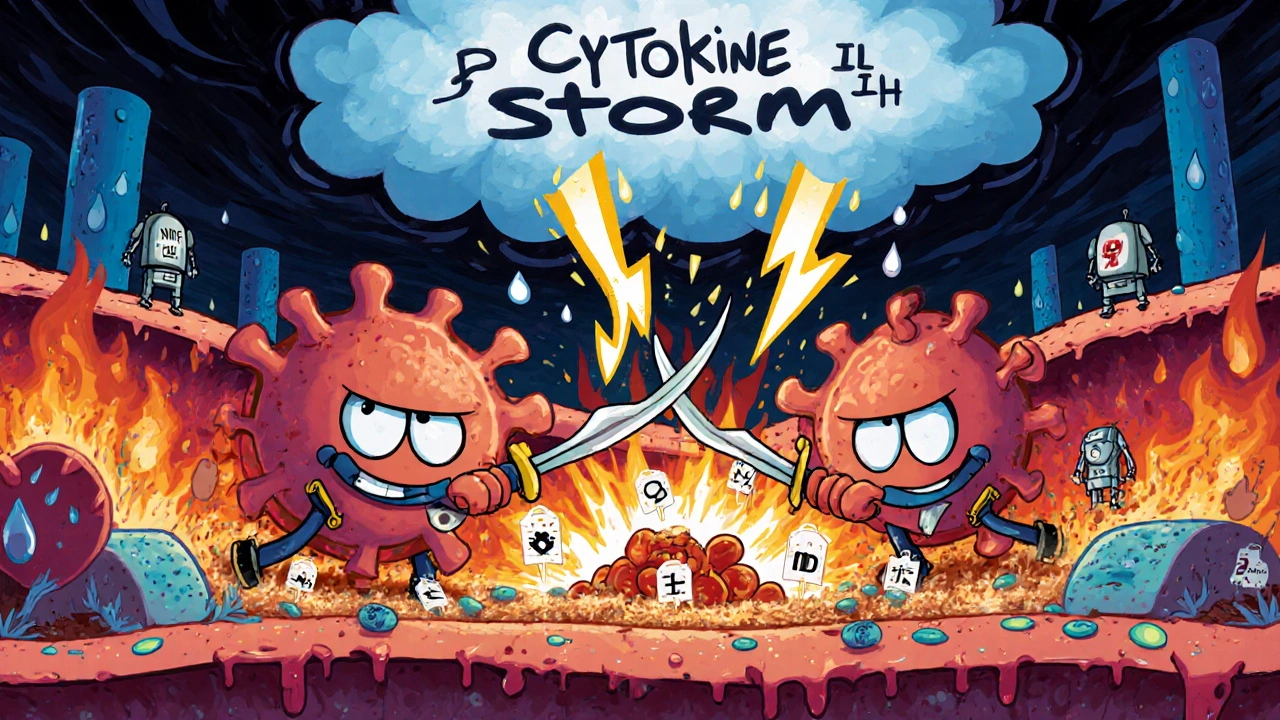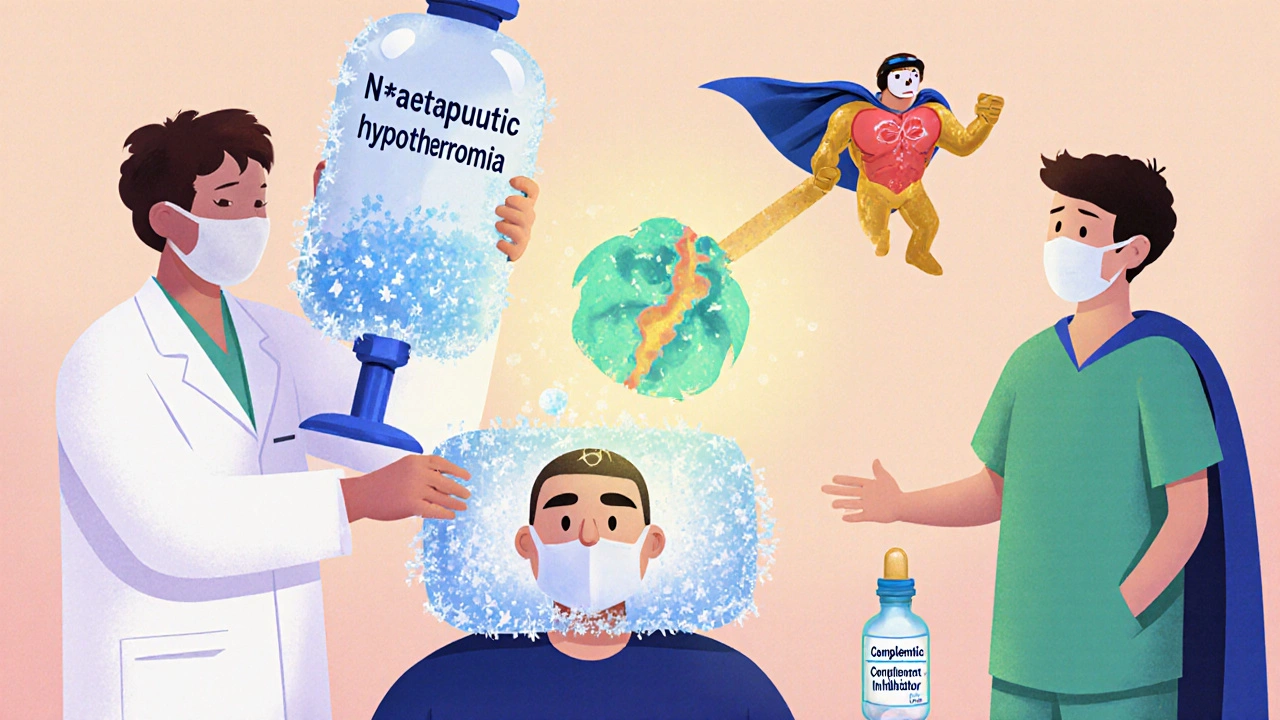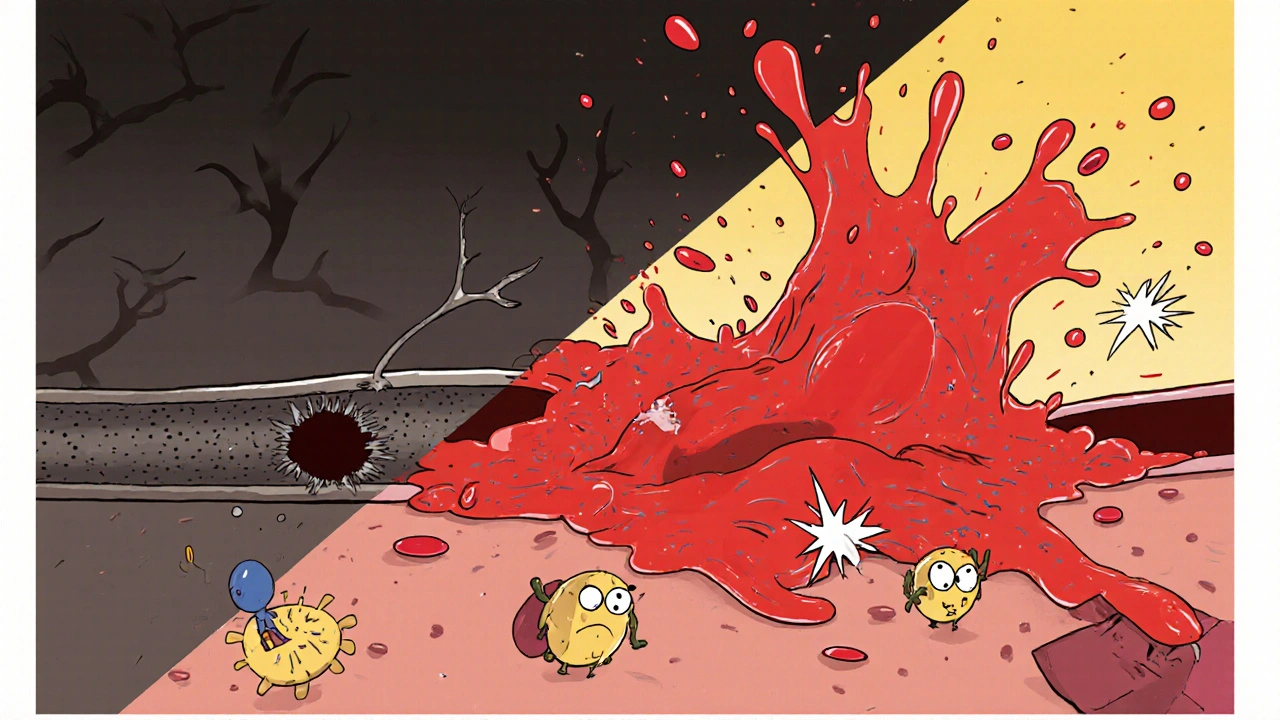Reperfusion Injury Therapy Selector
Select Clinical Scenario
Choose the specific clinical situation to view appropriate therapeutic strategies:
Myocardial Infarction
Heart attack where blood flow is restored to cardiac tissue
Ischemic Stroke
Brain injury from interrupted blood flow
Organ Transplantation
Donor organ reperfusion after cold ischemia
Peripheral Arterial Disease
Blood flow restoration to limbs after interventions
Recommended Therapies
Recommended Therapies
Select a clinical scenario to view therapies
Choose from the options above to see evidence-based therapeutic approaches
When tissue gets blood again after a blockage, a cascade known as reperfusion injury is a paradoxical damage caused by the sudden return of oxygen and nutrients, which sparks inflammation and oxidative stress can wreak havoc on cells that were just trying to survive a period of no blood flow.
What Exactly Is Reperfusion Injury?
In plain terms, reperfusion injury is the collateral damage that follows the restoration of blood supply to an organ after ischemia (a lack of blood). The instant blood arrives, reactive oxygen species (ROS) flood the tissue, and immune cells roar onto the scene. This double‑hit-first the oxygen debt, then the oxidative surge-can turn a life‑saving procedure into a source of lingering injury.
Why the Immune System Gets a Seat at the Table
Enter the immune system. It’s not just a passive observer; it actively amplifies the damage. Immune system disorders are conditions where the body’s defense mechanisms go awry, either over‑reacting or under‑reacting to threats often share the same inflammatory pathways that drive reperfusion injury. Think of a car crash: the airbags (immune response) protect you, but if they deploy too hard they can cause bruises (extra tissue injury).
Key Molecular Players Linking the Two Phenomena
- Oxidative stress is the imbalance between free radicals and antioxidant defenses, the prime suspect behind cell membrane rupture.
- Inflammation is the body’s alarm system that recruits white blood cells to the injury site, but too many recruits cause collateral damage.
- Neutrophils are the first‑line immune cells that release proteases and ROS, worsening injury.
- Cytokine storm is an uncontrolled release of signaling proteins like TNF‑α and IL‑1β that amplify inflammation.
- Complement system is a cascade of proteins that tags damaged cells for destruction, often over‑activated after reperfusion.
- Toll‑like receptors (TLRs) are pattern‑recognition receptors that sense danger signals and kick‑start inflammation.
- Mitoch ROS (mitochondrial ROS) are free radicals generated by stressed mitochondria, feeding the oxidative loop.
- Endothelial cells line blood vessels; when they become leaky they let immune cells flood the tissue.

Clinical Settings Where the Pairing Shows Up
Reperfusion injury isn’t a lab curiosity; it’s a real‑world problem in several high‑stakes scenarios:
- Myocardial infarction (heart attack): Opening a blocked coronary artery quickly saves the heart, but sudden blood flow can expand the infarct size by 20‑30%.
- Ischemic stroke: Restoring cerebral blood flow via thrombolysis or mechanical clot removal can trigger hemorrhagic transformation due to fragile vessels.
- Organ transplantation: Donor organs endure cold ischemia, and once transplanted, the reperfusion burst can impair graft function.
- Peripheral arterial disease procedures: Angioplasty restores flow to limbs, yet excessive inflammation can cause compartment syndrome.
In each case, patients often have underlying immune dysregulation-autoimmune disease, chronic infection, or even age‑related immune senescence-that magnifies the injury.
Therapeutic Strategies to Calm the Storm
Clinicians have a growing toolbox to blunt the reperfusion‑immune feedback loop. Below is a quick‑look comparison of the most talked‑about approaches.
| Approach | Primary Mechanism | Key Clinical Evidence | Typical Use Case |
|---|---|---|---|
| Antioxidants (e.g., N‑acetylcysteine) | Scavenge ROS, restore glutathione levels | Randomized trials in STEMI show ~15% reduction in infarct size | Acute myocardial infarction |
| Statins (pre‑loading) | Up‑regulate eNOS, anti‑inflammatory pleiotropy | Meta‑analysis of 12 RCTs links high‑dose statins to lower stroke hemorrhage | Ischemic stroke thrombolysis |
| Therapeutic hypothermia | Slows metabolism, dampens cytokine release | Guidelines recommend 33‑35°C for post‑cardiac arrest, improves neurologic outcome | Cardiac arrest, neonatal hypoxia |
| Complement inhibitors (e.g., C1‑esterase inhibitor) | Block downstream membrane attack complex formation | PhaseII trials in kidney transplantation show reduced delayed graft function | Organ transplant reperfusion |
| Stem cell therapy (mesenchymal) | Secrete anti‑inflammatory exosomes, promote tissue repair | Pilot studies in MI report improved ejection fraction at 6months | Experimental adjunct in heart and brain reperfusion |

Emerging Research and Future Directions
Scientists are now peering deeper into the molecular cross‑talk. A few hot topics:
- Gasotransmitters like hydrogen sulfide (H₂S) act as both antioxidants and signaling molecules; early animal work shows 30% less cellular death.
- RNA interference targeting TLR‑4 mRNA can mute the initial inflammatory surge; a PhaseI trial is recruiting for acute stroke.
- Nanoparticle‑delivered enzymes (e.g., catalase‑loaded liposomes) directly neutralize ROS at the injury site.
- Metabolic pre‑conditioning using brief, controlled bouts of ischemia before the main event (ischemic pre‑conditioning) activates protective kinases.
All these avenues share a common goal: uncouple the blood‑return benefit from the immune‑mediated harm.
Practical Checklist for Clinicians
- Identify high‑risk patients early (e.g., diabetics, elderly, known autoimmune disease).
- Consider pre‑loading with high‑dose statin or antioxidant if reperfusion is planned.
- Monitor biomarkers: troponin, CK‑MB, IL‑6, and serum lactate for early signal of injury.
- Apply therapeutic hypothermia within the first hour for cardiac arrest or severe stroke.
- Discuss adjunct therapies (e.g., complement inhibitors) in transplant multidisciplinary meetings.
- Document and reassess organ function at 24‑hour, 72‑hour, and 7‑day intervals to catch delayed injury.
Following this list can shave days off ICU stays and improve long‑term outcomes.
Frequently Asked Questions
What is the main difference between ischemia and reperfusion injury?
Ischemia is the lack of blood flow that starves cells of oxygen; reperfusion injury is the damage that occurs *after* blood rushes back in, driven by oxidative stress and inflammation.
Can healthy people experience reperfusion injury?
Yes, anyone who undergoes sudden restoration of blood-like after a heart attack or stroke-can develop some degree of reperfusion injury, even without pre‑existing immune disorders.
Are antioxidants a proven therapy for reperfusion injury?
Clinical trials show modest benefits (about a 10‑15% reduction in tissue damage) when antioxidants are given *before* reperfusion, but they are not yet standard of care.
How does the complement system worsen reperfusion injury?
Activation of complement creates membrane attack complexes that puncture cell membranes, and releases anaphylatoxins that draw more immune cells, amplifying the inflammatory cascade.
What future therapy looks most promising?
Targeted RNA interference of TLR‑4 and nanocarrier‑delivered enzymes are leading the pack in early‑phase trials, showing significant drops in ROS and cytokine levels.
Understanding the tight link between reperfusion injury and immune system disorders helps clinicians make smarter, evidence‑backed choices. By anticipating the immune backlash and applying the right adjuncts, you can turn a life‑saving reperfusion event into a truly healing one.

Roberta Makaravage
October 17, 2025 AT 02:45Reperfusion injury reads like a cautionary tale for modern medicine, a reminder that even well‑intentioned interventions can backfire when we ignore the body's innate wisdom. 😇 The sudden flood of oxygen is not just a miracle; it's a double‑edged sword that weaponizes reactive oxygen species against our own cells. Every time we rush a stent into a blocked artery, we must ask ourselves whether we are shepherds of healing or architects of collateral damage. The immune system does not sit idly by – neutrophils, cytokines, and complement proteins march in, eager to clean up, yet they often tear down the scaffolding we desperately need. This paradox forces us to confront a deeper ethical dilemma: are we treating the disease or compounding the trauma? In the context of autoimmune disorders, the stakes rise dramatically, because an over‑active immune response amplifies the injury beyond the tissue itself. The literature you cited about antioxidants and statins hints at a future where we pre‑emptively silence the inflammatory cascade before the blood rushes back. Moreover, novel approaches like gasotransmitters and nanocarriers could become the moral compass guiding us away from reckless reperfusion. We must also remember the patients – the elderly, the diabetics, the immunocompromised – whose fragile physiology makes them especially vulnerable to this oxidative onslaught. What is truly at risk is not just the myocardial wall or the cerebral cortex, but the very trust patients place in their clinicians. Every protocol should therefore embed a safety net: pre‑treatment with anti‑inflammatory agents, vigilant biomarker monitoring, and a willingness to pause and reassess. The science is clear: without respect for the immune backlash, our most heroic rescues can become tragic missteps. Let us embrace a more humble, measured approach, one that honors both the power of reperfusion and the humility required to temper it. 🌟
Mary Davies
October 19, 2025 AT 10:18The drama of blood rushing back into starving tissue is almost theatrical – the heart beats like a drum solo, the brain flickers like stage lights, and then the curtain falls with a burst of inflammation. The immune troops surge in like extras in a tragic play, each cytokine shouting its lines a little too loudly, and the audience (our patients) ends up with a bruised ego and a swollen organ. It's a spectacle we shouldn't have to watch, yet here we are, waiting for the next act of oxidative chaos.
Emily (Emma) Majerus
October 21, 2025 AT 17:51Nice recap, super helpful!
Virginia Dominguez Gonzales
October 24, 2025 AT 01:25Reading this feels like watching a heroic rescue that quickly turns into a tragic saga – the blood rushes back like a triumphant fanfare, only to be followed by a relentless storm of immune fireworks. The way you laid out the molecular players makes it feel like a battle scene, and I can’t help but cheer for the strategies that actually bring peace to the battlefield. Keep shining a light on these hidden villains!
Carissa Padilha
October 26, 2025 AT 08:58Sure, the paper sounds all scientific, but have you considered that big pharma might be hiding the real cure? They love pushing half‑baked antioxidant pills just to keep the market moving while the real, cheap solutions stay suppressed. Don't trust the mainstream narrative – the truth is out there, waiting for the right whistleblower.
Katie Henry
October 28, 2025 AT 16:31Excellent overview! Your breakdown of each therapeutic avenue provides a clear roadmap for clinicians seeking to mitigate reperfusion injury. I particularly appreciate the emphasis on pre‑loading high‑dose statins and the emerging data on complement inhibition. This level of detail empowers practitioners to make evidence‑based decisions that can truly improve patient outcomes.
Chris Beck
October 31, 2025 AT 00:05Honestly this is just buzzword fluff. Give us the simple truth: cut the blood flow and stop the drama. All these fancy drugs are a waste of time and money.
Emily Rankin
November 2, 2025 AT 07:38Imagine the body as a symphony, where each instrument-oxygen, immune cells, cytokines-must play in harmony. When reperfusion rushes in too loudly, the melody turns to cacophony. Yet, with the right conductors-statins, hypothermia, nanocarriers-we can restore the music and let healing resonate.
Lauren Sproule
November 4, 2025 AT 15:11Great post! Super clear and really useful for anyone on the floor. Thanks for breaking it down so nicely.
CHIRAG AGARWAL
November 6, 2025 AT 22:45Wow, another long read that probably nobody will actually use. I guess it’s nice to sound smart, but where’s the real world impact?
genevieve gaudet
November 9, 2025 AT 06:18From a cultural perspective, it’s fascinating how different medical traditions approach reperfusion-some rely on ancient herbs, others on cutting‑edge nanotech. Bridging these worlds could unlock even more innovative solutions.
Samantha Oldrid
November 11, 2025 AT 13:51Oh great, more “miracle cures” that will never see the light of day. 🙄 Save us the hype.
Malia Rivera
November 13, 2025 AT 21:25The science is solid, but let’s not forget the geopolitical angle-who profits from these therapies? Meanwhile, patients wait in the cold, hoping for a miracle that’s still in a lab notebook.
lisa howard
November 16, 2025 AT 04:58When I first read about reperfusion injury, I felt like I was stepping onto a stage where the actors were my own cells, the spotlight was the sudden surge of oxygen, and the plot twist was the immune system turning into a rogue troupe of villains. The narrative continues as neutrophils, those eager foot soldiers, rush in with their proteases, thinking they are heroes, but in reality, they are the ones tearing down the very walls they’re supposed to protect. It’s almost Shakespearean-“the better part of valor is discretion” – yet here we see a lack of discretion as ROS, the mischievous sprites, dance across membranes, leaving destruction in their wake. One cannot help but wonder: if the body is a finely tuned orchestra, why does a single misplaced note cause such cacophony? The answer, of course, lies in the delicate balance between restoration and over‑reaction. Every therapeutic intervention is a double‑edged sword, as the table you provided beautifully illustrates. Antioxidants might seem like the gentle lullaby that soothes the angry crowd, yet their efficacy is modest at best. Statins, on the other hand, are the seasoned conductors, coaxing the orchestra back into harmony, but even they cannot silence the entire storm. The emerging therapies-nanoparticle‑delivered enzymes, gasotransmitters-feel like avant‑garde composers experimenting with new instruments. Will they finally bring peace to this chaotic performance, or will they simply add another layer of complexity? Whatever the outcome, one thing remains clear: the audience-our patients-deserve a finale that is less tragic and more triumphant.
Cindy Thomas
November 18, 2025 AT 12:31Interesting read! 😊 I’ve seen similar patterns in my own research, and I think addressing the cytokine storm early could really shift outcomes.
Kate Marr
November 20, 2025 AT 20:05🔥💉🚀 Reperfusion therapy is evolving, and the future looks bright for patients who need it!
James Falcone
November 23, 2025 AT 03:38Cool breakdown – looks solid. Definitely something to keep an eye on.
Frank Diaz
November 25, 2025 AT 11:11While the overview is comprehensive, it skirts around the harsh reality that many of these “promising” interventions never make it past phase I. It’s a reminder to stay skeptical and demand real-world data before heralding any new therapy as a game‑changer.